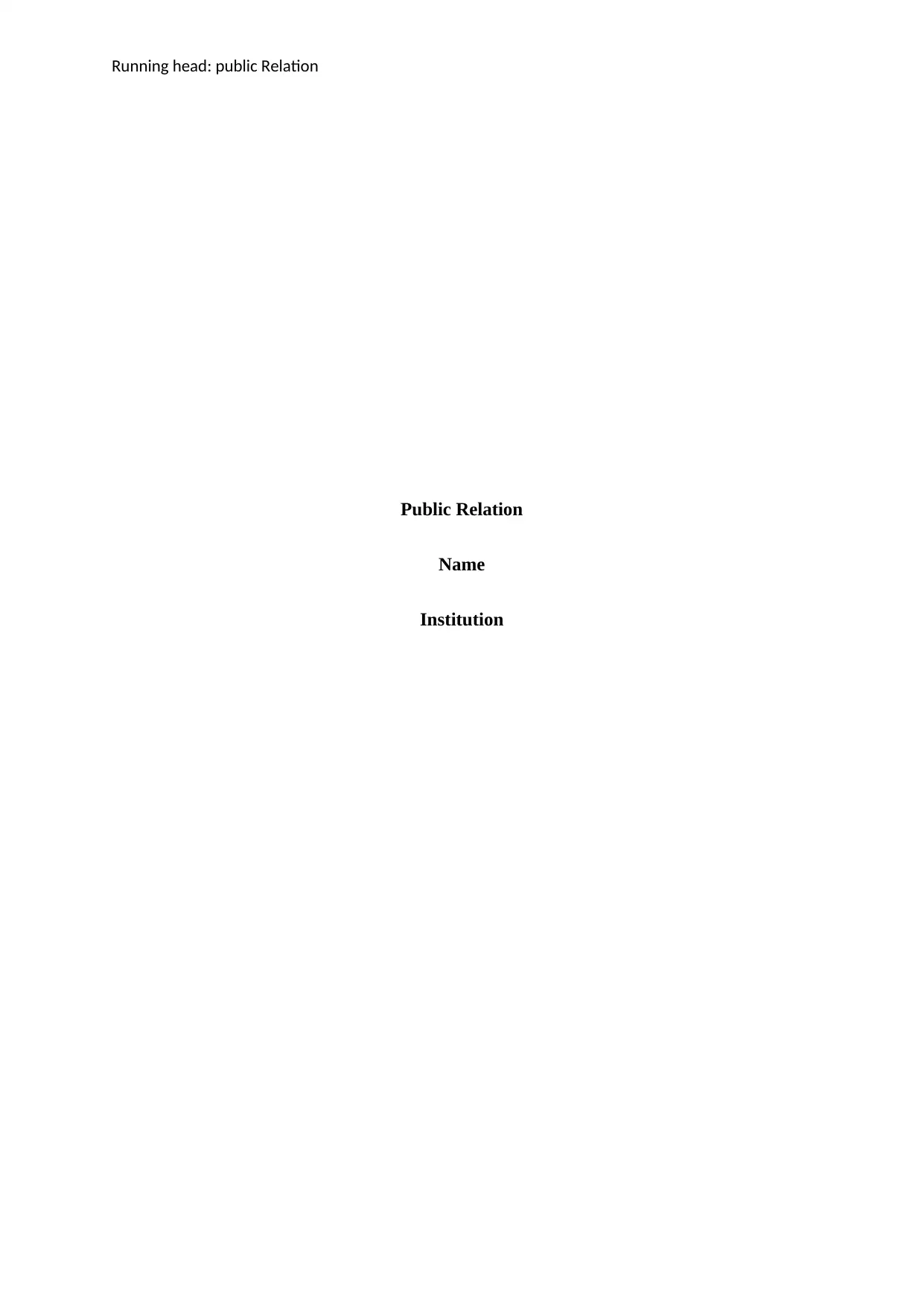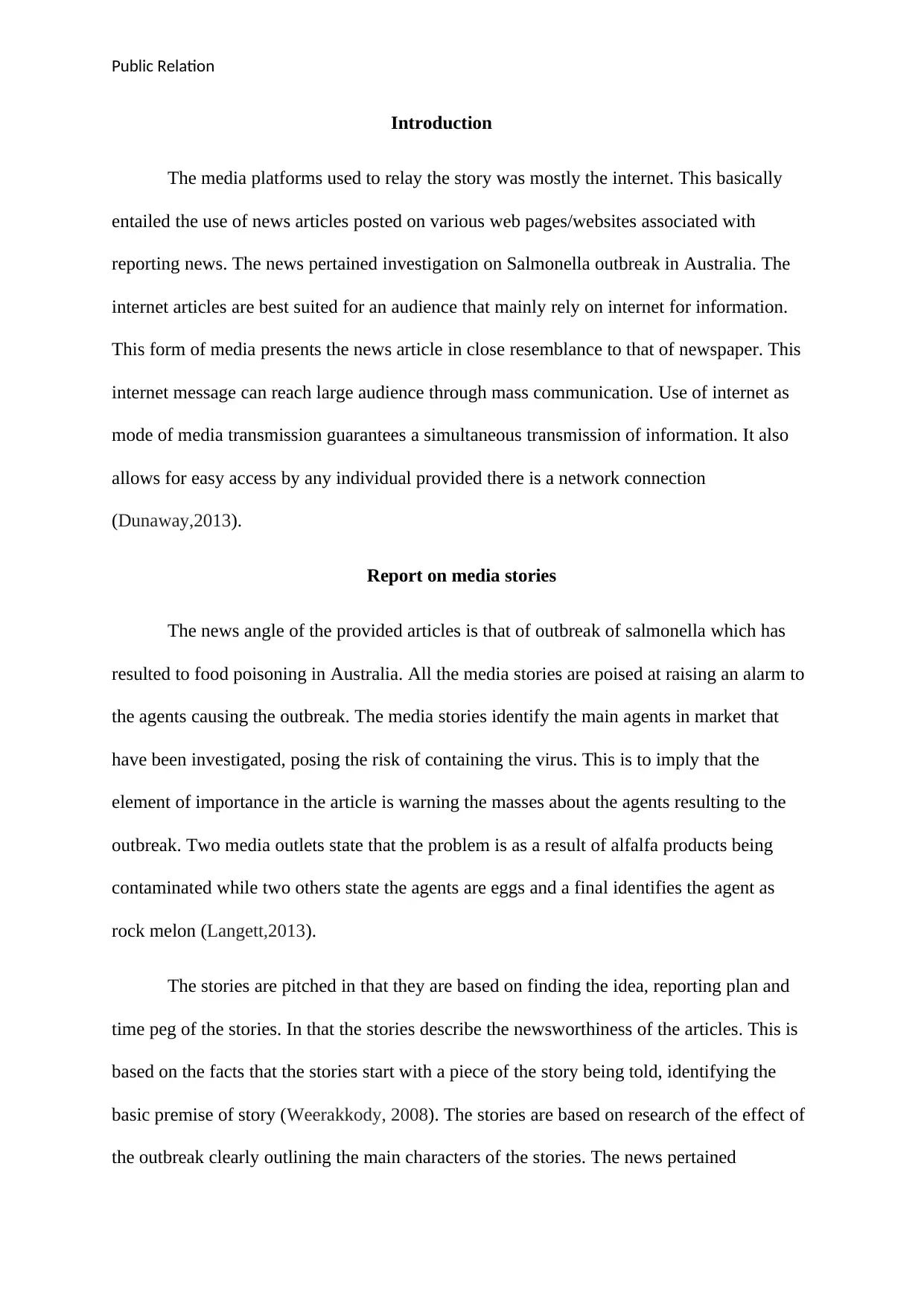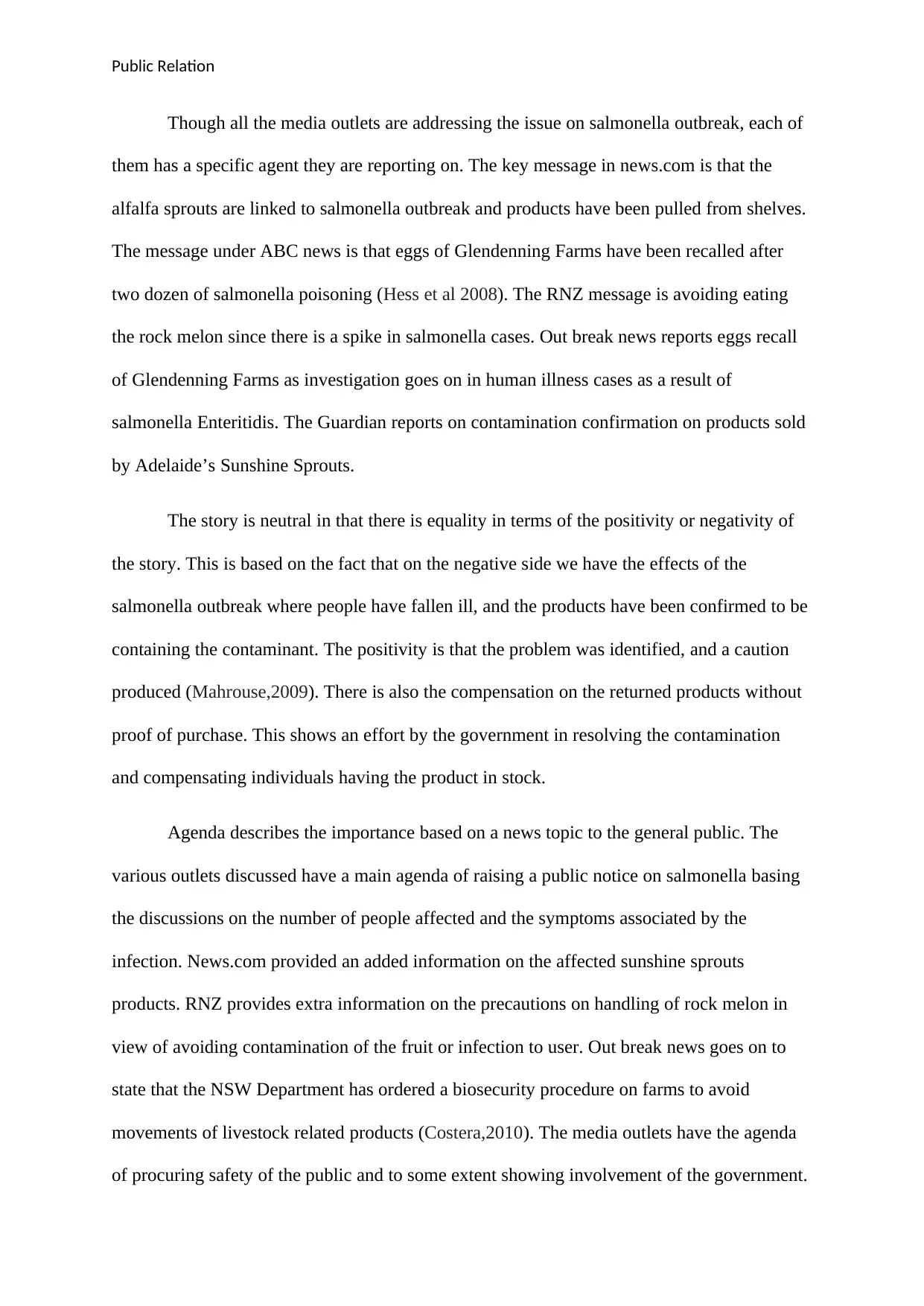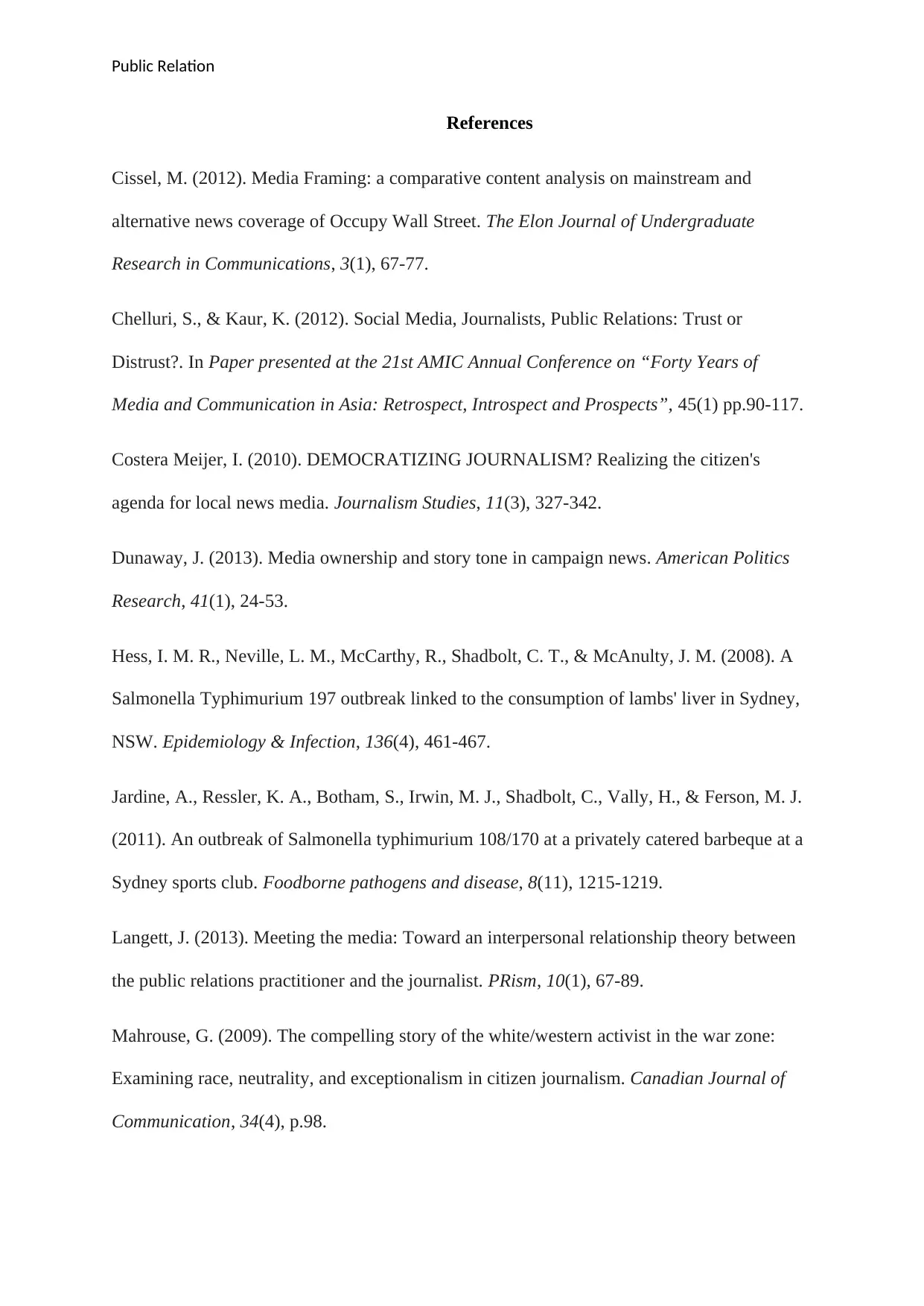Report: Analysis of Salmonella Outbreak in Public Relations
VerifiedAdded on 2023/06/04
|7
|1809
|106
Report
AI Summary
This report analyzes media coverage of a Salmonella outbreak in Sydney, Australia, focusing on five different media outlets. The report examines the angles of the stories, how they are pitched, and how framing and agenda-setting concepts are applied. The analysis includes identifying key messages, assessing the tone (positive, negative, or neutral), and comparing similarities and differences in reporting across various outlets. The report considers the target audience for each media platform and discusses the implications of the framing of the issue. The report also addresses the use of different media platforms, particularly the internet, and how they reach specific audiences. Finally, the report provides a detailed analysis of the outbreak, including the agents involved, the actions taken by the media, and the effects on the public. The report also mentions the use of quotations and research information from the various media outlets.

Running head: public Relation
Public Relation
Name
Institution
Public Relation
Name
Institution
Paraphrase This Document
Need a fresh take? Get an instant paraphrase of this document with our AI Paraphraser

Public Relation
Introduction
The media platforms used to relay the story was mostly the internet. This basically
entailed the use of news articles posted on various web pages/websites associated with
reporting news. The news pertained investigation on Salmonella outbreak in Australia. The
internet articles are best suited for an audience that mainly rely on internet for information.
This form of media presents the news article in close resemblance to that of newspaper. This
internet message can reach large audience through mass communication. Use of internet as
mode of media transmission guarantees a simultaneous transmission of information. It also
allows for easy access by any individual provided there is a network connection
(Dunaway,2013).
Report on media stories
The news angle of the provided articles is that of outbreak of salmonella which has
resulted to food poisoning in Australia. All the media stories are poised at raising an alarm to
the agents causing the outbreak. The media stories identify the main agents in market that
have been investigated, posing the risk of containing the virus. This is to imply that the
element of importance in the article is warning the masses about the agents resulting to the
outbreak. Two media outlets state that the problem is as a result of alfalfa products being
contaminated while two others state the agents are eggs and a final identifies the agent as
rock melon (Langett,2013).
The stories are pitched in that they are based on finding the idea, reporting plan and
time peg of the stories. In that the stories describe the newsworthiness of the articles. This is
based on the facts that the stories start with a piece of the story being told, identifying the
basic premise of story (Weerakkody, 2008). The stories are based on research of the effect of
the outbreak clearly outlining the main characters of the stories. The news pertained
Introduction
The media platforms used to relay the story was mostly the internet. This basically
entailed the use of news articles posted on various web pages/websites associated with
reporting news. The news pertained investigation on Salmonella outbreak in Australia. The
internet articles are best suited for an audience that mainly rely on internet for information.
This form of media presents the news article in close resemblance to that of newspaper. This
internet message can reach large audience through mass communication. Use of internet as
mode of media transmission guarantees a simultaneous transmission of information. It also
allows for easy access by any individual provided there is a network connection
(Dunaway,2013).
Report on media stories
The news angle of the provided articles is that of outbreak of salmonella which has
resulted to food poisoning in Australia. All the media stories are poised at raising an alarm to
the agents causing the outbreak. The media stories identify the main agents in market that
have been investigated, posing the risk of containing the virus. This is to imply that the
element of importance in the article is warning the masses about the agents resulting to the
outbreak. Two media outlets state that the problem is as a result of alfalfa products being
contaminated while two others state the agents are eggs and a final identifies the agent as
rock melon (Langett,2013).
The stories are pitched in that they are based on finding the idea, reporting plan and
time peg of the stories. In that the stories describe the newsworthiness of the articles. This is
based on the facts that the stories start with a piece of the story being told, identifying the
basic premise of story (Weerakkody, 2008). The stories are based on research of the effect of
the outbreak clearly outlining the main characters of the stories. The news pertained

Public Relation
investigation on Salmonella outbreak in Australia. The internet articles are best suited for an
audience that mainly rely on internet for information. This form of media presents the news
article in close resemblance to that of newspaper. This internet message can reach large
audience through mass communication. Use of internet as mode of media transmission
guarantees a simultaneous transmission of information. The news shows a sense of timeliness
by identifying the reason of doing the story piece at the moment. All this act in finding the
focus of the story.
Framing a story involves agenda-setting tradition where a news is written by focusing
on issues at hand rather than focusing on particular topic. The stories are being framed by
introducing a piece of the main news as the heading of the news. This helps in setting the
stage for the news prompting the reader to understand more on what is going to be relayed in
the article (Matthes,2009). The headings of the news focus on main event of the news story
which is later placed into the story. The introduction section of the stories makes use of
pictures helping in identifying characters of the news. The news related examination on
Salmonella episode in Australia. The web articles are most appropriate for a group of people
that predominantly depend on web for data. This type of media displays the news article in
close likeness to that of daily paper. This web message can contact substantial gathering of
people through mass correspondence.
The story is being reported as a caution message to its audience in regard to the
outbreak of salmonella. The articles address the masses on the implication of using the
outlined market agents that is eggs, alfalfa products and rock melon providing the number
that is already affected by the outbreak in the area in concern. The story is also being reported
as a precaution message to those who have already bought the products to avoid using the
products or returning them to the company in concern to get compensation on the same
(Jardine et al 2011).
investigation on Salmonella outbreak in Australia. The internet articles are best suited for an
audience that mainly rely on internet for information. This form of media presents the news
article in close resemblance to that of newspaper. This internet message can reach large
audience through mass communication. Use of internet as mode of media transmission
guarantees a simultaneous transmission of information. The news shows a sense of timeliness
by identifying the reason of doing the story piece at the moment. All this act in finding the
focus of the story.
Framing a story involves agenda-setting tradition where a news is written by focusing
on issues at hand rather than focusing on particular topic. The stories are being framed by
introducing a piece of the main news as the heading of the news. This helps in setting the
stage for the news prompting the reader to understand more on what is going to be relayed in
the article (Matthes,2009). The headings of the news focus on main event of the news story
which is later placed into the story. The introduction section of the stories makes use of
pictures helping in identifying characters of the news. The news related examination on
Salmonella episode in Australia. The web articles are most appropriate for a group of people
that predominantly depend on web for data. This type of media displays the news article in
close likeness to that of daily paper. This web message can contact substantial gathering of
people through mass correspondence.
The story is being reported as a caution message to its audience in regard to the
outbreak of salmonella. The articles address the masses on the implication of using the
outlined market agents that is eggs, alfalfa products and rock melon providing the number
that is already affected by the outbreak in the area in concern. The story is also being reported
as a precaution message to those who have already bought the products to avoid using the
products or returning them to the company in concern to get compensation on the same
(Jardine et al 2011).
⊘ This is a preview!⊘
Do you want full access?
Subscribe today to unlock all pages.

Trusted by 1+ million students worldwide

Public Relation
Though all the media outlets are addressing the issue on salmonella outbreak, each of
them has a specific agent they are reporting on. The key message in news.com is that the
alfalfa sprouts are linked to salmonella outbreak and products have been pulled from shelves.
The message under ABC news is that eggs of Glendenning Farms have been recalled after
two dozen of salmonella poisoning (Hess et al 2008). The RNZ message is avoiding eating
the rock melon since there is a spike in salmonella cases. Out break news reports eggs recall
of Glendenning Farms as investigation goes on in human illness cases as a result of
salmonella Enteritidis. The Guardian reports on contamination confirmation on products sold
by Adelaide’s Sunshine Sprouts.
The story is neutral in that there is equality in terms of the positivity or negativity of
the story. This is based on the fact that on the negative side we have the effects of the
salmonella outbreak where people have fallen ill, and the products have been confirmed to be
containing the contaminant. The positivity is that the problem was identified, and a caution
produced (Mahrouse,2009). There is also the compensation on the returned products without
proof of purchase. This shows an effort by the government in resolving the contamination
and compensating individuals having the product in stock.
Agenda describes the importance based on a news topic to the general public. The
various outlets discussed have a main agenda of raising a public notice on salmonella basing
the discussions on the number of people affected and the symptoms associated by the
infection. News.com provided an added information on the affected sunshine sprouts
products. RNZ provides extra information on the precautions on handling of rock melon in
view of avoiding contamination of the fruit or infection to user. Out break news goes on to
state that the NSW Department has ordered a biosecurity procedure on farms to avoid
movements of livestock related products (Costera,2010). The media outlets have the agenda
of procuring safety of the public and to some extent showing involvement of the government.
Though all the media outlets are addressing the issue on salmonella outbreak, each of
them has a specific agent they are reporting on. The key message in news.com is that the
alfalfa sprouts are linked to salmonella outbreak and products have been pulled from shelves.
The message under ABC news is that eggs of Glendenning Farms have been recalled after
two dozen of salmonella poisoning (Hess et al 2008). The RNZ message is avoiding eating
the rock melon since there is a spike in salmonella cases. Out break news reports eggs recall
of Glendenning Farms as investigation goes on in human illness cases as a result of
salmonella Enteritidis. The Guardian reports on contamination confirmation on products sold
by Adelaide’s Sunshine Sprouts.
The story is neutral in that there is equality in terms of the positivity or negativity of
the story. This is based on the fact that on the negative side we have the effects of the
salmonella outbreak where people have fallen ill, and the products have been confirmed to be
containing the contaminant. The positivity is that the problem was identified, and a caution
produced (Mahrouse,2009). There is also the compensation on the returned products without
proof of purchase. This shows an effort by the government in resolving the contamination
and compensating individuals having the product in stock.
Agenda describes the importance based on a news topic to the general public. The
various outlets discussed have a main agenda of raising a public notice on salmonella basing
the discussions on the number of people affected and the symptoms associated by the
infection. News.com provided an added information on the affected sunshine sprouts
products. RNZ provides extra information on the precautions on handling of rock melon in
view of avoiding contamination of the fruit or infection to user. Out break news goes on to
state that the NSW Department has ordered a biosecurity procedure on farms to avoid
movements of livestock related products (Costera,2010). The media outlets have the agenda
of procuring safety of the public and to some extent showing involvement of the government.
Paraphrase This Document
Need a fresh take? Get an instant paraphrase of this document with our AI Paraphraser

Public Relation
The media stories identify the main agents in market that have been investigated, posing the
risk of containing the virus. This is to imply that the element of importance in the article is
warning the masses about the agents resulting to the outbreak.
The major similarity in the outlets is the caution on salmonella outbreak and
identification of the agents causing the outbreak. The Guardian, News and ABC news makes
use of quotation words implying direct source of information while the other outlets don’t.
Similar topic varies slightly in information structuring and headings also vary. Outlet News
provides extra information on the egg salmonella infection compared to The guardian and
ABC news (Cissel, 2012). Research information has similarities like the number of victims
infected or the number of samples that were contaminated.
The target audience is a society that has an easy accessibility to the internet network.
The audience relay on internet media in order to access news on issues affecting their
country. The information being relayed is possibly affecting the target audience directly since
it provides for possible precautions and prevention to salmonella outbreak.
Conclusion
Being an important news in terms of health concern it’s safe to assume that the target
audience gets most of its important news from the internet websites (Chelluri & Kaur, 2012).
The issue is framed in a way to show that the target audience is mainly based in Sydney
Australia. The framing of the issue shows that the target audience is conversant with English
and some scientific terminologies.
The media stories identify the main agents in market that have been investigated, posing the
risk of containing the virus. This is to imply that the element of importance in the article is
warning the masses about the agents resulting to the outbreak.
The major similarity in the outlets is the caution on salmonella outbreak and
identification of the agents causing the outbreak. The Guardian, News and ABC news makes
use of quotation words implying direct source of information while the other outlets don’t.
Similar topic varies slightly in information structuring and headings also vary. Outlet News
provides extra information on the egg salmonella infection compared to The guardian and
ABC news (Cissel, 2012). Research information has similarities like the number of victims
infected or the number of samples that were contaminated.
The target audience is a society that has an easy accessibility to the internet network.
The audience relay on internet media in order to access news on issues affecting their
country. The information being relayed is possibly affecting the target audience directly since
it provides for possible precautions and prevention to salmonella outbreak.
Conclusion
Being an important news in terms of health concern it’s safe to assume that the target
audience gets most of its important news from the internet websites (Chelluri & Kaur, 2012).
The issue is framed in a way to show that the target audience is mainly based in Sydney
Australia. The framing of the issue shows that the target audience is conversant with English
and some scientific terminologies.

Public Relation
References
Cissel, M. (2012). Media Framing: a comparative content analysis on mainstream and
alternative news coverage of Occupy Wall Street. The Elon Journal of Undergraduate
Research in Communications, 3(1), 67-77.
Chelluri, S., & Kaur, K. (2012). Social Media, Journalists, Public Relations: Trust or
Distrust?. In Paper presented at the 21st AMIC Annual Conference on “Forty Years of
Media and Communication in Asia: Retrospect, Introspect and Prospects”, 45(1) pp.90-117.
Costera Meijer, I. (2010). DEMOCRATIZING JOURNALISM? Realizing the citizen's
agenda for local news media. Journalism Studies, 11(3), 327-342.
Dunaway, J. (2013). Media ownership and story tone in campaign news. American Politics
Research, 41(1), 24-53.
Hess, I. M. R., Neville, L. M., McCarthy, R., Shadbolt, C. T., & McAnulty, J. M. (2008). A
Salmonella Typhimurium 197 outbreak linked to the consumption of lambs' liver in Sydney,
NSW. Epidemiology & Infection, 136(4), 461-467.
Jardine, A., Ressler, K. A., Botham, S., Irwin, M. J., Shadbolt, C., Vally, H., & Ferson, M. J.
(2011). An outbreak of Salmonella typhimurium 108/170 at a privately catered barbeque at a
Sydney sports club. Foodborne pathogens and disease, 8(11), 1215-1219.
Langett, J. (2013). Meeting the media: Toward an interpersonal relationship theory between
the public relations practitioner and the journalist. PRism, 10(1), 67-89.
Mahrouse, G. (2009). The compelling story of the white/western activist in the war zone:
Examining race, neutrality, and exceptionalism in citizen journalism. Canadian Journal of
Communication, 34(4), p.98.
References
Cissel, M. (2012). Media Framing: a comparative content analysis on mainstream and
alternative news coverage of Occupy Wall Street. The Elon Journal of Undergraduate
Research in Communications, 3(1), 67-77.
Chelluri, S., & Kaur, K. (2012). Social Media, Journalists, Public Relations: Trust or
Distrust?. In Paper presented at the 21st AMIC Annual Conference on “Forty Years of
Media and Communication in Asia: Retrospect, Introspect and Prospects”, 45(1) pp.90-117.
Costera Meijer, I. (2010). DEMOCRATIZING JOURNALISM? Realizing the citizen's
agenda for local news media. Journalism Studies, 11(3), 327-342.
Dunaway, J. (2013). Media ownership and story tone in campaign news. American Politics
Research, 41(1), 24-53.
Hess, I. M. R., Neville, L. M., McCarthy, R., Shadbolt, C. T., & McAnulty, J. M. (2008). A
Salmonella Typhimurium 197 outbreak linked to the consumption of lambs' liver in Sydney,
NSW. Epidemiology & Infection, 136(4), 461-467.
Jardine, A., Ressler, K. A., Botham, S., Irwin, M. J., Shadbolt, C., Vally, H., & Ferson, M. J.
(2011). An outbreak of Salmonella typhimurium 108/170 at a privately catered barbeque at a
Sydney sports club. Foodborne pathogens and disease, 8(11), 1215-1219.
Langett, J. (2013). Meeting the media: Toward an interpersonal relationship theory between
the public relations practitioner and the journalist. PRism, 10(1), 67-89.
Mahrouse, G. (2009). The compelling story of the white/western activist in the war zone:
Examining race, neutrality, and exceptionalism in citizen journalism. Canadian Journal of
Communication, 34(4), p.98.
⊘ This is a preview!⊘
Do you want full access?
Subscribe today to unlock all pages.

Trusted by 1+ million students worldwide

Public Relation
Matthes, J. (2009). What's in a frame? A content analysis of media framing studies in the
world's leading communication journals, 1990-2005. Journalism & Mass Communication
Quarterly, 86(2), pp.349-367.
Weerakkody, N. (2008). Research methods for media and communication. Oxford University
Press, 89(13), pp.67-69.
Matthes, J. (2009). What's in a frame? A content analysis of media framing studies in the
world's leading communication journals, 1990-2005. Journalism & Mass Communication
Quarterly, 86(2), pp.349-367.
Weerakkody, N. (2008). Research methods for media and communication. Oxford University
Press, 89(13), pp.67-69.
1 out of 7
Your All-in-One AI-Powered Toolkit for Academic Success.
+13062052269
info@desklib.com
Available 24*7 on WhatsApp / Email
![[object Object]](/_next/static/media/star-bottom.7253800d.svg)
Unlock your academic potential
Copyright © 2020–2025 A2Z Services. All Rights Reserved. Developed and managed by ZUCOL.